A super-simple device that shows magnetic lines of force
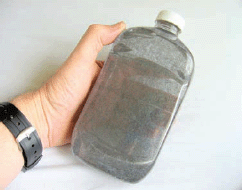
Figure A: A 3D Magnetic Viewer ready to reveal invisible magnetic lines of force
A super-simple device that shows magnetic lines of force

Figure A: A 3D Magnetic Viewer ready to reveal invisible magnetic lines of force
My job takes me to various research labs where I install powerful magnetic systems and train technicians in how to use them. This time, I needed a magnetic field viewer to show lines of force. This Instructable shows how to construct such a device using nothing more than steel wool fibers and mineral oil. I built this one while at my hotel.
1. Get your supplies
I went to Wal-Mart and bought the following items:
 Fine steel wool
Fine steel wool
 Bottle of mineral oil in plastic bottle
Bottle of mineral oil in plastic bottle
 Scissors
Scissors
2. Cut the steel wool
Using the scissors, cut the steel wool into small, short pieces. About a tablespoon of cut wool should be enough. Spread out newspaper on your work surface and try not to get clippings all over the place.
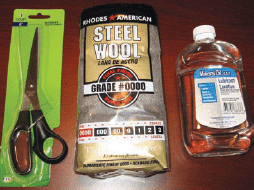
Figure B: What you’ll need to make your viewer
3. Place in bottle of oil
Place the cut steel wool in the bottle of mineral oil. Clean the top of the bottle with a paper towel so that you’ll get a good seal. Squeeze the sides of the bottle as you put on the cap to burp out the remaining air. Shake to disperse the fibers.
Important note: Clean up any mess, and dispose of excess fibers immediately. Place it in a plastic bag so it doesn’t spread everywhere. The longer your mess sits around, the more likely it will spread.
4. Test your viewer
Place a magnet against the bottle. The viewer will display the magnetic lines of force as seen in Figure E.
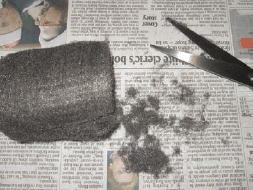
Figure C: Cut the wool into tiny pieces
Figure D: Tiny pieces of steel wool are dispersed in the oil and line up in three-dimensions to show the field
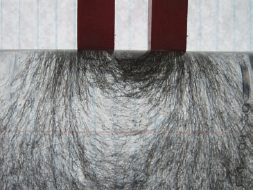
Figure E: Testing the effectiveness of the viewer
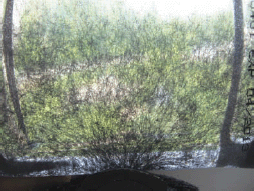
Figure F: Lines of force from the cell phone case magnet are shown
5. Using the viewer
Placing the 3D Magnetic Field Viewer near a mobile phone shows the pattern of magnetic lines emanating from the phone’s case.
User Notes
Chris Cashion wrote in to say that he thought this device was neat and that he planned on building one. He said that instead of using steel wool, he was going to use ferrous dirt particles.
Which led Bill to reply: Some of those particles may be micrometeorites. We get rained upon several tons a day around the world. I saw a project somewhere on the Internet that shows how you can collect them by using a funnel with a baggie-contained magnet. The collected rain will have micrometeorites that will stick to the outside of the baggie. You can use a large, clean plastic tarp to increase the area. Micrometeorites look like little rounded blobs and dumbells. This would make a good Instructable, but first I better find some references to cite the source.
After doing a quick search “collecting micrometeorites” I found this: tinyurl.com/6ycwom. And here is a lesson on collecting micrometeorites from California State University Fresno: tinyurl.com/5hn8cw (PDF).
And the ubiquitous Kiteman followed with: You could have checked a little closer to home: www.instructables.com/id/Give-your-lovedone-a-real-fallen-star-this-Chri
Bill Sherman says: “All my life I’ve had a passion for science and how things work. Working as an electronics engineer has given me the tools and opportunities to learn even more. I spend my spare time building robots, artbots, and sharing these activities with my family.”